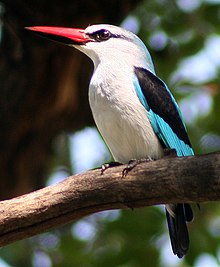Tree Kingfisher
| Tree kingfishers | |
|---|---|
 |
|
|
Woodland kingfisher (Halcyon senegalensis) |
|
| Scientific classification | |
| Kingdom: | Animalia |
| Phylum: | Chordata |
| Class: | Aves |
| Order: | Coraciiformes |
| Family: | Alcedinidae |
| Subfamily: | Halcyoninae |
| Genera | |
The tree kingfishers or wood kingfishers, subfamily Halcyoninae, are the most numerous of the three families of birds in the kingfisher group, with between 56 and 61 species in around 12 genera, including several species of kookaburras. The family appears to have arisen in Indochina and Maritime Southeast Asia and then spread to many areas around the world. Tree kingfishers are widespread through Asia and Australasia, but also appear in Africa and the islands of the Pacific and Indian Oceans, using a range of habitats from tropical rainforest to open woodlands.
The tree kingfishers are short-tailed, large-headed, compact birds with long, pointed bills. Like other Coraciiformes, they are brightly coloured. Most are monogamous and territorial, nesting in holes in trees or termite nests. Both parents incubate the eggs and feed the chicks. Although some tree kingfishers frequent wetlands, none are specialist fish-eaters. Most species dive onto prey from a perch, mainly taking slow-moving invertebrates or small vertebrates.
The tree kingfisher subfamily Halcyoninae is one of nine in the order Coraciiformes, which also includes the motmots, bee-eaters, todies, rollers, ground-rollers, cuckoo roller, and two other subfamilies of kingfishers. The rollers do not appear to be particularly closely related to the other groups, and the Coraciiformes are therefore probably polyphyletic. In the past, all kingfishers were placed in the Alcedinidae, but the three subfamilies appear to have diverged early.
Between 56 and 61 species are placed in around 12 genera. The species in this subfamily are quite well known; the vagueness of the count reflects controversies in the taxonomy of this family more than any gross lack of data on the birds; the present arrangement of genera seems to be supported by molecular analyses, although the relationship of many genera to one another is still unresolved.
...
Wikipedia
